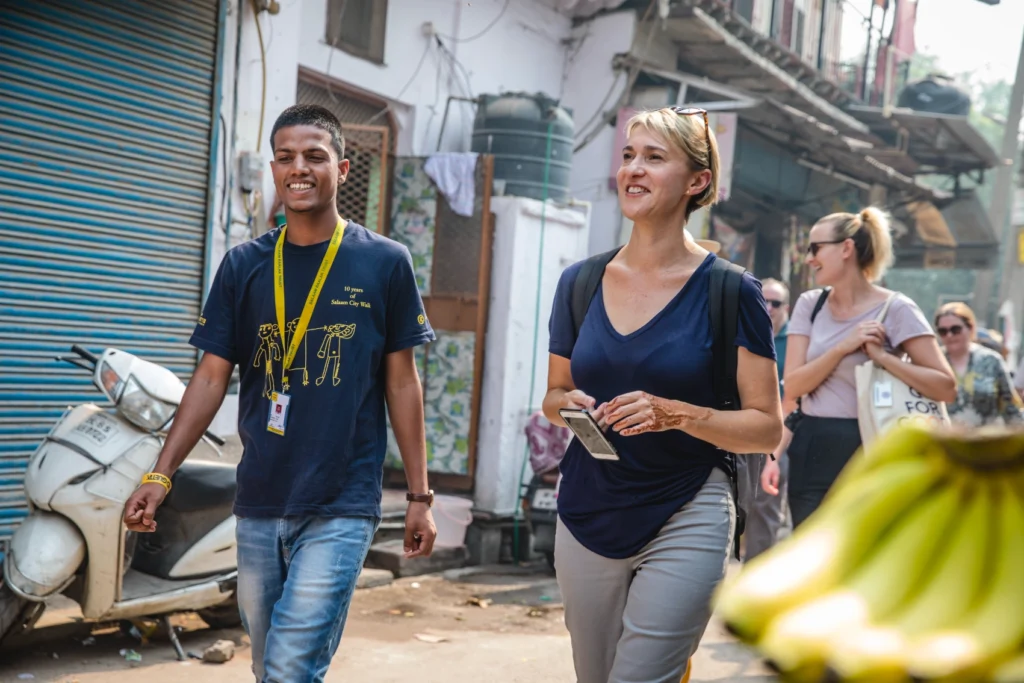
Rushes of colour and aromas, majestic monuments, sacred temples, and modern cities: travellers have so many ways to experience India. The sooner you dive into this culturally rich and diverse country, the sooner you find yourself with a bucket list that’s growing faster than it’s shrinking. With so many incredible places to visit in India, it can feel impossible to know where to start.
But don’t fear. Whether you’re looking for a quick taste of what India has to offer or seeking to build an extensive itinerary covering multiple regions, you can’t go wrong with the Golden Triangle. An area formed by the three most frequently visited cities in the northwest of India — Delhi, Agra, and Jaipur — the region boasts some of the country’s most sought-after sites and experiences.
Best time to visit India’s Golden Triangle
To get the most out of a visit to the Golden Triangle, October to March is a good time to go. During these months, you’ll enjoy cool, dry, and typically sunny weather, even if temperatures drop a little in December and January.
Avoid April to September. While it’s tempting to say a resounding “yes, please!” to cheaper rates and smaller crowds, the summer months are brutally hot — about 40°C (104°F) — and the monsoon season follows swiftly after, bringing downpours, high humidity, and occasional flooding.
Top attractions in the Golden Triangle
The Golden Triangle is full of captivating landmarks and must-do experiences, and we’re not just talking about the dots of the triangle, which is why we’ve included a few en-route points of interest that fall outside of (but close to) the cities of Delhi, Agra, and Jaipur.
Immerse yourself in dynamic Delhi
A capital city where the past and future intertwine, Delhi is home to three UNESCO World Heritage Sites and centuries-old mosques, as well as a modern metro system and wide boulevards boasting chic urban spaces. Take a journey through the ages with a visit to the Red Fort, wonder at the Indo-Islamic architecture of Qutub Minar, and explore Humayun’s Tomb, the forerunner to the Taj Mahal. Finish the day by ordering delicious Indian street food, such as paratha flatbreads or deep-fried jalebi, and take a sunset tuk-tuk ride to India Gate.
The following morning, get ready to dodge rickshaws, motorbikes, and even the odd cow as you get lost in the labyrinth of Chandni Chowk market, one of the busiest markets in Old Delhi. Expect stalls loaded with spices and dried fruit, baskets filled with traditional sweets, and the intoxicating aroma of essential oils.

See it for yourself on: Essential India
Witness the majesty of Agra’s architecture
Agra is home to India’s most iconic building: the Taj Mahal. This immense marble mausoleum is a masterpiece not to be missed. Time your visit early — sunrise going into morning light — or in the afternoon leading into sunset. The hues of the stone shift throughout the day, but you’ll experience this phenomenon more intensely if you visit around dawn or dusk.
A little more than 3km (1.8 mi) northwest is Agra Fort, a 16th-century Mughal fortress of red sandstone. A showcase of grand halls and royal chambers, it joins a long list of exceptional structures dotted throughout Agra, including the Gurudwara Guru Ka Taal (a place of pilgrimage for Sikhs) and the tomb of Itmad-ud-Daula, known as the “Baby Taj.”

See it for yourself on: Delhi to Kathmandu Adventure
Step into the past at Fatehpur Sikri
Journey 40km (25 mi) west of Agra to Fatehpur Sikri, a small city founded by 16th-century Mughal Emperor Akbar. Another hot spot for history enthusiasts, this UNESCO World Heritage Site boasts incredible red sandstone structures, from the sacred Jama Masjid (Great Mosque) to its colossal southern entrance gateway, the Buland Darwaza. Visit the Tomb of Salim Chishti within the quadrangle of the Great Mosque. This white marble mausoleum features beautiful carvings and ornamental mosaics and is a fine example of Mughal architecture in the region.
See it for yourself on: Essential India & Maldives Sailing
Visit the enchanting Chand Baori stepwell in Abhaneri
No trip to India is complete without gazing at the geometric poetry of one of its thousands of stepwells. These multi-story underground structures are complex feats of engineering that were essential for navigating the oscillating extremes of dry heat and monsoon rain during the year. In the village of Abhaneri, about 95km (59 mi) from Jaipur, Chand Baori is one of India’s oldest and most visually striking stepwells. A maze of 3,500 narrow steps across 13 stories, it’s a magnet for photographers and visitors seeking to bathe in the serene atmosphere of the site.
See it for yourself on: The Best of India & Bhutan
Experience rustic charm in Dhula
As you close in on Jaipur, detour to Dhula village. This tranquil escape into rural Rajasthan offers a welcome retreat from days of bustle and noise at busy sites. Opt for an overnight glamping experience in a cozy tent for a full detox and enjoy stargazing by the fire against a mountainous backdrop. Travellers also have opportunities to connect with local traditions. Enjoy folk dance performances, sample artisanal crafts, and savour the flavours of authentic Rajasthani cuisine. Influenced by arid climatic conditions and rustic cooking techniques, Rajasthani curries have a unique profile that will leave you begging for seconds.
See it for yourself on: Golden Triangle
Explore Jaipur, the jewel of Rajasthan
Continue through Rajasthan to Jaipur, the “Pink City,” so-named for its rosy buildings. Make stops at colourful markets like the Johari Bazaar and Bapu Bazaar, and take in the beauty of the Jal Mahal, a picturesque palace built in 1699 that appears to be floating. Visit the City Palace, including the Mubarak Mahal and museums showcasing royal artifacts.
When you’re done, head 12km (7.5 mi) from the city to Amber Fort, a majestic hilltop complex built with yellow and pink sandstone and white marble. Gaze up at the intricate carvings and impressive architecture before being dazzled in the Sheesh Mahal (Mirror Palace).

See it for yourself on: Golden Triangle Independent Adventure—Delhi, Agra & Jaipur
Essential tips for India’s Golden Triangle
Visas are required for many international travellers to India, so leave enough time for yours to be processed. You might also want to consider getting travel vaccines and boosters, including typhoid, hepatitis B, and rabies, which can take up to six months to fully administer.
Once you arrive in India, be wary of food and water hygiene, and use purified water when brushing your teeth. Avoid carrying high-value bills. Using smaller bills is less conspicuous and makes quick transactions smoother.
Golden Triangle India packing list
– Breathable, loose-fitting clothing made from cotton or linen
– Zippable pockets or subtle storage for your wallet and phone
– Pashmina to cover your shoulders and knees at religious sites
– Waterproof coat or a warmer jacket for the winter months
– Sandals
– Comfortable, closed-toe shoes
– High-SPF sunscreen; smog can mask the sun’s intensity, so apply sun lotion regardless of the visible weather conditions
– Sun hat
– Sunglasses
– Medications
– Travel insurance
– Insect repellent
– Hand sanitizer
– Local currency
– Power adapter
– Portable charger

